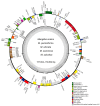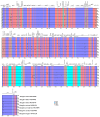Comparative and Phylogenetic Analysis of Complete Chloroplast Genomes of Five Mangifera Species
- PMID: 40565558
- PMCID: PMC12192436
- DOI: 10.3390/genes16060666
Comparative and Phylogenetic Analysis of Complete Chloroplast Genomes of Five Mangifera Species
Abstract
Background/Objectives: Mango, which is known as the "King of Tropical Fruits", is an evergreen plant belonging to the Anacardiaceae family. It belongs to the genus Mangifera, which comprises 69 species of plants found in tropical and subtropical regions, including India, Indonesia, the Malay Peninsula, Thailand, and South China. However, research on the structural information of complete chloroplast genomes of Mangifera is limited. Methods: The rapid advancement of high-throughput sequencing technology enables the acquisition of the entire chloroplast (cp) genome sequence, providing a molecular foundation for phylogenetic research. This work sequenced the chloroplast genomes of six Mangifera samples, performed a comparative analysis of the cp genomes, and investigated the evolutionary relationships within the Mangifera genus. Results: All six Mangifera samples showed a single circular molecule with a quadripartite structure, ranging from 157,604 bp to 158,889 bp in length. The number of RNA editing sites ranged from 60 to 61, with ndhB exhibiting the highest number of RNA editing sites across all species. Seven genes-namely, atpB, cemA, clpP, ndhD, petB, petD, and ycf15-exhibited a Ka/Ks value > 1, suggesting they may be under positive selection. Phylogenetic analysis revealed that Mangifera siamensis showed a close relationship between Mangifera indica and Mangifera sylvatica. Conclusions: Our comprehensive analysis of the whole cp genomes of the five Mangifera species offers significant insights regarding their phylogenetic reconstruction. Moreover, it elucidates the evolutionary processes of the cp genome within the Mangifera genus.
Keywords: Illumina; Mangifera; chloroplast genome; phylogenetic analysis; polymorphism analysis.
Conflict of interest statement
The authors declare no conflicts of interest.
Figures









References
-
- Bajpai A., Muthukumar M., Ahmad I., Ravishankar K., Parthasarthy V., Sthapit B., Rao R., Verma J., Rajan S. Molecular and morphological diversity in locally grown non-commercial (heirloom) mango varieties of North India. J. Environ. Biol. 2016;37:221. - PubMed
-
- Iquebal M., Jaiswal S., Mahato A.K., Jayaswal P.K., Angadi U., Kumar N., Sharma N., Singh A.K., Srivastav M., Prakash J. MiSNPDb: A web-based genomic resources of tropical ecology fruit mango (Mangifera indica L.) for phylogeography and varietal differentiation. Sci. Rep. 2017;7:14968. doi: 10.1038/s41598-017-14998-2. - DOI - PMC - PubMed
-
- Dutta S., Srivastav M., Rymbai H., Chaudhary R., Singh A., Dubey A., Lal K. Pollen–pistil interaction studies in mango (Mangifera indica L.) cultivars. Sci. Hortic. 2013;160:213–221. doi: 10.1016/j.scienta.2013.05.012. - DOI
-
- Sherman A., Rubinstein M., Eshed R., Benita M., Ish-Shalom M., Sharabi-Schwager M., Rozen A., Saada D., Cohen Y., Ophir R. Mango (Mangifera indica L.) germplasm diversity based on single nucleotide polymorphisms derived from the transcriptome. BMC Plant Biol. 2015;15:277. doi: 10.1186/s12870-015-0663-6. - DOI - PMC - PubMed
Publication types
MeSH terms
Grants and funding
LinkOut - more resources
Full Text Sources
Miscellaneous

